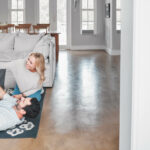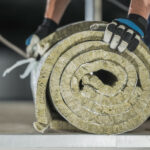Underfloor heating (UFH) systems, also known as radiant floor heating, are an innovative way of heating homes that involves warming the space from the ground up. They remove the need for radiators or baseboard heaters, transforming the design of a space. Additionally, UFH systems improve energy efficiency and distribution. Since heat rises, starting at ground level means that less energy is wasted compared to conventional heating methods and is more consistent throughout the room.
Preparing the subfloor for an underfloor heating system is crucial in ensuring its efficiency and longevity. A properly prepared subfloor provides a stable base for the heating elements to be installed, preventing any shifting or damage that can occur over time.
On the other hand, a subfloor which is not appropriately prepared for a UFH system installation can lead to structural, aesthetic and functional issues. This may result in expensive repairs and replacements once installed.
The following instructions for subfloor preparation are aimed to support the installation of a UFH system.
- Inspect for Health and Safety
First, inspect for any signs of water damage or structural issues that may need addressing before you proceed with any new flooring installation. Abnormalities can include soft spots, cracks or discolouration.
Test the moisture content of the floors using a moisture metre, such as a hygrometer. High levels of moisture in the subfloor can lead to mould growth, rot, and other issues that can compromise the strength of the flooring above but can be potentially solved at this stage.
- Install Screed to Level and Strengthen the Floor
Ensure that the floor is sufficiently level and structurally sound before beginning the process. Installing a screed UFH system will level the floor and improve heat output produced by the system. Screed acts as a thick layer of material that is poured onto the subfloor and then levelled out to create an even base for the final flooring material. This material is traditionally cement-based or, for liquid screeds, calcium sulphate-based. The screeding process helps to eliminate any imperfections in the subfloor and provides a stable, flat level foundation for the final floor covering like vinyl, tiles, wood flooring, or other finishes. It also enables a more even distribution of heat, reducing energy consumption and improving the rooms comfort.
To select the correct UFH system and screed, consider the type of floor covering and thickness of floor you have available to install the system with, as different types of screeds/systems have varying thickness and properties suited to different purposes. Liquid screeds are ideal for underfloor heating systems due to their self-levelling properties and full encapsulation of the heating pipes resulting in a more efficient heat distribution. Other factors include speed of heat up and total heat out required, which will be different per install.
- Add Insulating Materials
Combining a UFH system with insulating materials can help enhance the overall performance of the system by preventing heat loss downwards into the ground below. This not only increases energy efficiency but also ensures a more comfortable and sustainable heating experience.
Incorporating insulating materials into your flooring can also enhance soundproofing qualities within your space. Whether you live in a bustling city or have noisy neighbours, adding insulation to your floors can significantly reduce the transmission of sound between different levels of your home or building.
Consider using screed to provide that solid floor performance, reducing noise and creaking compared to non-screed systems. Different types of screeds can offer specific benefits such as improved heat output or rapid drying times to make the UFH system install quicker.
- Clean the Floor
Lastly, ensure a subfloor is clean before and after installations, allowing time for the area to dry completely before proceeding with any further installation or repairs.
Clean a subfloor by removing any debris, dust, or dirt from the surface using a broom or vacuum. For optimal results, consider applying a primer or sealant to the cleaned subfloor to prevent moisture buildup and mould growth.





